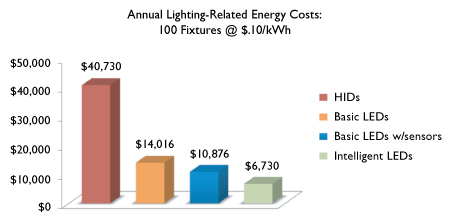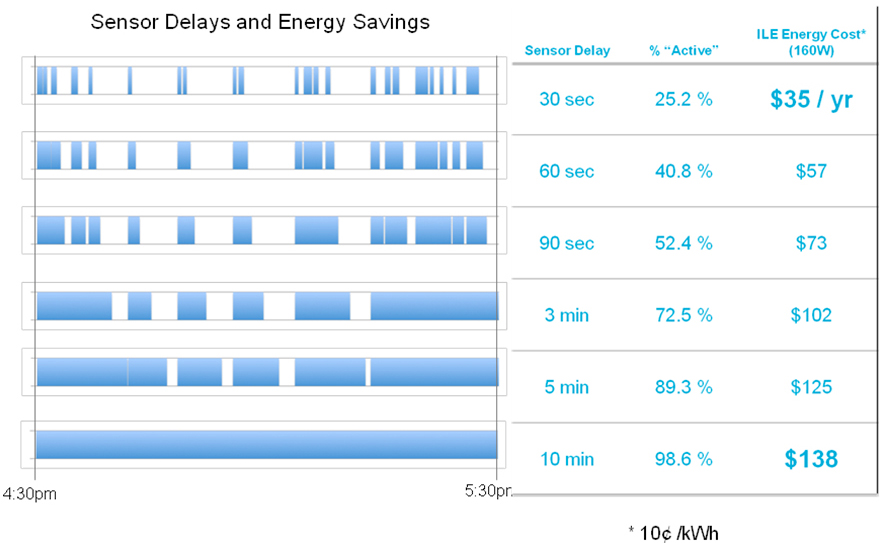Guide to Choosing the Right LEDs
Updated on 05/29/19
As predictable and cheaper energy costs are receding, there is a greater demand on efficient lighting solutions in the commercial sector
Today energy use related to lighting consumes up to 38% of the total energy budget, making efficiency a top priority in commercial facilities. It is this growing need for efficiency that is at the heart of LED lighting solutions with documented efficiency of 50-90% over HID alternative
Savings however vary widely from 50-90% based on type of LED fixture. This articles provides guidelines that should be considered to maximise the efficiency and reliability of commercial lighting which choosing LED
Levels of Efficiency
There are 3 different levels of efficiency with LEDS
50% Savings incorporating energy efficient LEDs that are otherwise functionally equivalent to HIDs with no control and a simple on/off switch
70% Savings multi-vendor configuration of basic bolt on aftermarket occupancy or daylight solutions
90% Savings intelligent lighting systems which is the only lighting category that can routinely deliver continual saving of 90% featuring software controls built in occupancy sensors and daylight harvesting

Components of Efficiency
Luminous Efficacy. The correct criteria for determining the efficiency of a light fixture is its lumens/Watt ratio, which represents how much light the fixture delivers versus what it consumes to perform. This value is called luminous efficacy. High lamp efficacy is better because it requires less units of power to provide the same levels of light output
Thermal Heat Dissipation. LEDs run at lower temperatures and produce less heat wastage with most of the power converted to light output and reducing temperature rises at commercial facilities making cooling and refrigeration systems work more efficiently
Cycling Frequent on/off switching cycling further increases LEDs usable life span
Lighting Control for Efficiency
In the simplest terms efficient lighting control is controlling all variables to eliminate unnecessary use of lighting which are
- Lighting only WHEN needed
- Lighting only WHERE needed
- Exactly the right AMOUNT of light
This is usually achieved by a lighting design with the flexibility to control when and where the lighting is used through the use of occupancy sensors, daylight harvesting and ability to schedule lighting scenes. A good lighting system provides maximum flexibility around all elements of lighting use such as
- Can the lights sense whether they should be off based on activity or ambient levels?
- Can the lights be dimmed to any level?
- Can the light output levels be customised to less than 100% when in use?
- Can the lighting settings be optimised to meet specific scenes, for example cleaning, work schedules, emergency’s or holidays
Control In Practice
Occupancy even at the busiest industrial facilities, space occupancy is rarely above 30% and frequently less than 10%, so by turning LEDs on/off or dimming them real dollar significant savings are achieved due to lower overall lighting time
Dimming For times when turning lights off is not viable but rather security lighting is required, dimming strategies can be used of 10-20% rather than fully on which can have a significant contribution to bottom line savings
Timeout Settings Controlling amount of time lighting fixtures stay on after an area is vacated may seem minor but it can mean real energy savings
- 100 fixtures with 30-second settings will cost $3,500/yr
- 100 fixtures with 60-second settings will cost $5,700/yr
- 100 fixtures with 90-second settings will cost $7,300/yr

Lamp Life.
- High quality industrial luminaires have lifetime ratings of 50-90,000hrs compared to 20,000 of traditional sources. SunLED fixture are all rated above 50,000hrs
International Safety Certification
- Best practise requires not only component level approvals but UL/CE listing of the entire fixture as well.
Warranty
- Minimum 5 year manufacturer’s warranty is recommended, which should include the complete system. Many manufacturers only provide a pass through warranty for each part which is essentially no warranty at all



